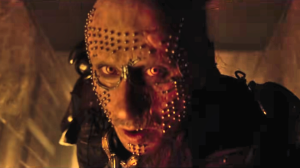Strange. Weird. Odd. You’re going to read or hear these words a lot when digging through reviews of Doom Patrol #1.
Videos by ComicBook.com
You wouldn’t be wrong to apply any of them either, but they fail to provide a subjective portrait of a comic that is most certainly all of these things. They establish that Doom Patrol is unlike other things, that it is unique, and that is true. But being different doesn’t inform whether something is intelligently crafted or ignorantly assembled, purposefully twisted or haphazardly random. The real question to ask regarding Doom Patrol #1 is: Is this comic exceptional?
Those sorts of descriptions focus primarily on the plotting of Doom Patrol, but the success or failure of each element of plotting relies on the debut’s most striking feature: its visual presentation. The very first page casts an unclear set of narration over a set of four images that may be moments already passed, yet to come, or mere possibilities. What could have easily fallen into the cliched trap of showing the end of the story instead becomes a dreamlike reverie on permanence and transience. Tamra Bonvillain colors these unique moments in darkening shades of violet pushing them down the road and away from the present, coated like a sunset.
When the story refocuses on Casey Brinke, apparently the newest protagonist of the Doom Patrol, it takes place at night, but the bright lights of ambulances and street lamps sharply refocus the story. It’s an artful transition that sets the tone and setting for this narrative perfectly. Artist Nick Derington makes Casey instantly likeable as her face and body language is filled with warmth and energy. She manages to be nervous and confident in a uniquely human way whether she’s gripping the wheel of an ambulance or plugging away at arcade games.

Writer Gerard Way’s internal monologue and dialogue in relation to Casey fuse his love of comics writing with lyrical sensibilities. From the very start of her narration, beautifully lettered by Todd Klein on torn scraps from a notebook, it’s clear who she is. She speaks of her mother flying into the sun after telling her to “Be a bright light in a black hole” in a story that works on both a metaphorical and literal level. It’s never made clear in this issue how a moment like this should be read, but that’s perfectly okay. There is a clear sense of who Casey is and why her life matters, and that is enough to make everything else worth puzzling out.
While Casey and her partner Samson form the heart of this issue, Doom Patrol #1 is loaded with a lot more than his irresistible pair of protagonists. There’s a detour to the interior of a gyro loaded with pop culture references, puns, and a brilliant alteration in style. There’s references to Grant Morrison’s beloved run on Doom Patrol with lots of bricks that manage to function with or without that context. There’s Terry None who is loaded with shocking party tricks. You could call all of this strange, but it’s better than strange. It’s inventive and imaginative, pushing boundaries and exploring ideas. There’s a whole lot of setup in each of these elements, but they function within this issue as well, as something new worth seeing simply to expand horizons and expectations.
Only time (and additional issues) will tell whether Doom Patrol is a comic that will last and be remembered as exceptional. In this moment at least, it certainly seems to be. Doom Patrol #1 is a stunning comic on a purely visual level, with Derington, Bonvillain, and Klein all on their best form. They present a single issue story so pleasing to the eye that even if its promises and questions remain unfulfilled, it will remain notable nonetheless. And there is a great deal of promise in the story being told. Ideas are carefully layered and characters constructed to allow for the sort of sprawl that still makes Morrison’s Doom Patrol a high watermark of superhero comics. As of right now, the only thing to do is buy the ticket and take the ride.
Grade: B+








